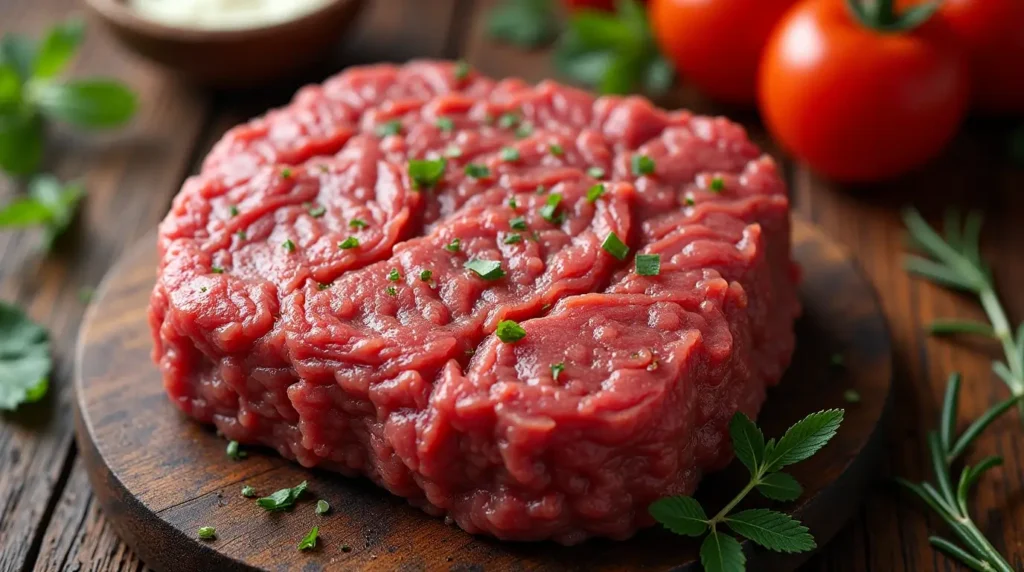Explore the ground beef nutrition profile, including calories, protein, fats, and vitamins. Learn how to incorporate it into a balanced diet.
Welcome! Today, we delve deep into the ground beef nutrition landscape. This common ingredient provides vital nutrients. However, it’s essential to understand its composition for a healthy diet. Therefore, we will cover everything from calories to micronutrients. Specifically, this article offers a complete guide. Ground beef is a versatile food, but its nutritional value varies. Consequently, informed choices can lead to better health. We aim to empower you with this knowledge.
What Makes Up Ground Beef Nutrition: A Detailed Breakdown
Calories in Ground Beef
Firstly, let’s look at the calorie content. Ground beef nutrition varies significantly based on its fat content. For example, lean ground beef contains fewer calories. On the other hand, fattier versions contain more. Typically, a 3-ounce serving of 85% lean ground beef provides approximately 170 calories. In contrast, the same serving of 70% lean can reach 220 calories or more. Hence, choosing the right lean percentage is crucial for calorie management.
Protein Content in Ground Beef Nutrition
Next, we examine the protein content. Ground beef is an excellent source of protein. Consequently, it’s a vital nutrient for muscle growth and repair. In general, a 3-ounce serving of ground beef offers about 22 grams of protein. Furthermore, this makes it a powerhouse of protein for your diet. Therefore, if you want to increase your protein intake, ground beef is a good option.
Fat Content in Ground Beef
The fat content in ground beef is important. Ground beef nutrition is largely determined by fat percentage. Different lean percentages significantly affect total fat. For example, 85% lean ground beef has significantly less fat. Conversely, 70% lean contains more fat. Moreover, saturated fat is the primary fat type in ground beef. Therefore, moderation is key when consuming higher-fat ground beef.
Micronutrients in Ground Beef
In addition to macronutrients, ground beef provides important micronutrients. These include B vitamins, especially vitamin B12. Ground beef also provides iron, zinc, and selenium. Specifically, iron from ground beef is highly absorbable. Additionally, it is essential for preventing anemia. Moreover, zinc supports the immune system. Therefore, including ground beef in your diet provides essential vitamins and minerals.
PrintGround Beef Nutrition Facts
- Total Time: 25 minutes
- Yield: 4 servings 1x
Description
This simple ground beef and veggie skillet is a balanced, high-protein meal that’s quick to make and full of nutrients. Great for meal prep, low-carb diets, or an easy weeknight dinner.
Ingredients
1 pound lean ground beef (90% lean or higher)
1 tablespoon olive oil
1 bell pepper, chopped
1 zucchini, chopped
1 small onion, diced
2 cloves garlic, minced
1/2 teaspoon salt
1/2 teaspoon black pepper
1/2 teaspoon smoked paprika
1/4 teaspoon dried oregano
1 cup baby spinach (optional)
Instructions
1. In a large skillet, heat olive oil over medium heat. Add onion and cook for 2–3 minutes.
2. Add ground beef, breaking it up with a spatula. Cook until browned and cooked through.
3. Stir in garlic, bell pepper, zucchini, and all seasonings. Cook for 5–7 minutes until vegetables are tender.
4. Stir in spinach and cook until wilted, about 1 minute.
5. Taste and adjust seasoning if needed. Serve hot or store for meal prep.
Notes
Use extra-lean beef to lower saturated fat and calories.
This recipe is naturally gluten-free and low-carb.
Serve with rice, quinoa, or tortillas for a more filling option.
- Prep Time: 10 minutes
- Cook Time: 15 minutes
- Category: Main Course
- Method: Stovetop
- Cuisine: American
Nutrition
- Serving Size: 1 1/4 cups
- Calories: 290
- Sugar: 3g
- Sodium: 420mg
- Fat: 17g
- Saturated Fat: 6g
- Unsaturated Fat: 10g
- Trans Fat: 0g
- Carbohydrates: 7g
- Fiber: 2g
- Protein: 26g
- Cholesterol: 75mg
Keywords: ground beef nutrition, healthy ground beef recipe, low carb skillet, high protein dinner
The Impact of Lean Percentage on Ground Beef Nutrition

90% Lean Ground Beef
- 90% lean ground beef is one of the leanest options available. Consequently, it has the lowest fat content. The ground beef nutrition of 90% lean is beneficial. Particularly, it is beneficial for those watching their fat intake.
- Calories: Approximately 150 per 3-ounce serving
- Fat: About 5 grams per 3-ounce serving
- Protein: Roughly 22 grams per 3-ounce serving
- Pros: Great for low-fat diets, high protein content
- Cons: Can be drier and less flavorful due to lower fat content.
85% Lean Ground Beef
- 85% lean ground beef offers a good balance. Furthermore, it has a good amount of flavor and a reasonable fat content. Ground beef nutrition at this percentage is versatile. Therefore, this is a great option for a multitude of meals.
- Calories: Approximately 170 per 3-ounce serving
- Fat: Around 7-10 grams per 3-ounce serving
- Protein: About 22 grams per 3-ounce serving
- Pros: Versatile, good flavor profile, moderately lean
- Cons: Higher fat than 90% lean.
80% Lean Ground Beef
- 80% lean ground beef is another popular choice. Specifically, it has a higher fat content than 85% and 90%. Ground beef nutrition at 80% lean has its benefits. It produces a more tender and flavorful patty.
- Calories: Approximately 200 per 3-ounce serving
- Fat: Around 12-15 grams per 3-ounce serving
- Protein: Approximately 20-22 grams per 3-ounce serving
- Pros: Juicy, rich flavor, good for burgers and recipes where fat is needed for moisture
- Cons: Higher fat content.
70% Lean Ground Beef
- 70% lean ground beef contains the most fat. Furthermore, this offers the most flavor but isn’t the healthiest. Ground beef nutrition at this level will impact your overall health.
- Calories: 220-250 calories per 3-ounce serving.
- Fat: Around 15-20 grams per 3-ounce serving.
- Protein: 20-22 grams per 3-ounce serving.
- Pros: Very flavorful and moist, great for dishes where fat adds richness.
- Cons: Highest fat content, may not be the healthiest choice.
Ground Beef Nutrition: The Importance of Protein for Health

Muscle Building and Repair
Firstly, protein is crucial for muscle building. Specifically, ground beef provides high-quality protein. Furthermore, this protein aids in muscle repair after exercise. Moreover, this is essential for athletes and active individuals. Consequently, a diet including ground beef promotes muscle health.
Satiety and Weight Management
Protein is essential for satiety. Furthermore, it helps you feel fuller for longer. Including ground beef in your meals can reduce overall calorie intake. Therefore, it is beneficial for weight management. Moreover, this can lead to better weight control.
Essential for Growth and Development
Protein from ground beef is vital for growth and development. Specifically, it supports cell growth and repair. Furthermore, it aids in the production of enzymes and hormones. Consequently, adequate protein intake from ground beef is essential.
Role in Immune Function Ground Beef Nutrition
Protein plays a critical role in immune function. The amino acids from ground beef support immune cells. Hence, this helps the body fight off infections. Moreover, the zinc content in ground beef further enhances immune response. Therefore, including ground beef in your diet boosts your immunity.
The Role of Fat in Ground Beef Nutrition
Types of Fats in Ground Beef Nutrition
Ground Beef Nutrition contains mainly saturated fats. Additionally, it contains some monounsaturated fats. Specifically, saturated fats can raise cholesterol levels. Moreover, this is particularly true when consumed in large amounts. Consequently, choosing leaner ground beef is important. Also, this ensures you maintain a heart-healthy diet.
Saturated Fat Considerations
While saturated fat in moderation isn’t bad, it is important to be aware of your overall intake. Saturated fat should be consumed in moderation. In addition, it is important to choose lean cuts of ground beef. Moreover, the ground beef nutrition facts of lean choices are better for heart health. Furthermore, a balanced diet and regular exercise are important to a heart-healthy diet.
Unsaturated Fats
Ground beef also contains some unsaturated fats. These are generally considered healthier fats. However, the primary fat in ground beef is saturated. Therefore, portion control and lean choices are crucial. Consequently, this is important for managing fat intake.
Fat and Flavor
Fat in ground beef contributes significantly to its flavor. For example, higher-fat ground beef often has a richer taste. Therefore, you may need to adjust cooking methods if using lean ground beef. Additionally, this can improve flavor retention. Consequently, it’s essential to balance flavor with your health goals.
Key Vitamins and Minerals in Ground Beef Nutrition

Vitamin B12
Ground beef is a great source of Vitamin B12. Specifically, this is essential for nerve function. Furthermore, it aids in red blood cell formation. Moreover, a deficiency in B12 can lead to fatigue and neurological problems. Therefore, including ground beef in your diet can ensure an adequate intake.
Iron
- Iron from ground beef is highly absorbable. Moreover, it’s vital for carrying oxygen in the blood. Iron deficiency can cause anemia. Ground beef nutrition addresses this issue. Furthermore, including ground beef in your diet supports iron levels.
Zinc
- Zinc in ground beef supports immune function. Furthermore, it is important for cell growth. Zinc also supports wound healing. Ground beef nutrition plays a role in supporting your immune system. Additionally, it aids in cellular processes.
Selenium
Selenium is an essential mineral found in ground beef. It is a powerful antioxidant. Therefore, it helps protect cells from damage. Also, it supports thyroid function. Ground beef nutrition aids in maintaining overall health. Furthermore, selenium contributes to overall well-being.
Ground Beef Nutrition: Comparisons to Other Protein Sources
Comparison to Chicken
Chicken is also a lean protein source. However, ground beef provides more iron and B vitamins. Chicken has less fat than some ground beef options. Moreover, the ground beef nutrition profile is different. Therefore, choose the protein that best suits your specific needs.
Comparison to Fish
Fish is rich in omega-3 fatty acids. While ground beef provides different benefits, such as iron and B12. Fish can be lower in saturated fat than ground beef. Additionally, their nutritional profiles vary significantly. Consequently, a balanced diet includes both.
Comparison to Plant-Based Proteins
Plant-based proteins, like beans and lentils, are high in fiber. Ground beef, conversely, is a complete protein source. Moreover, they have different micronutrient profiles. Therefore, diversifying your protein sources is beneficial. Consequently, your diet will be more nutritious.
Ground Beef Nutrition and a Balanced Diet
A balanced diet includes a variety of protein sources. Ground beef is a good choice to add to that rotation. In addition, it provides key nutrients. Moreover, you should choose the leanest options that align with your goals. Also, it’s important to balance other options into your meal plan. Furthermore, a diverse diet will provide all the necessary nutrients.
Incorporating Ground Beef into a Healthy Diet
Choosing Lean Cuts
Firstly, choose lean cuts of ground beef. Specifically, 90% lean or 93% lean. This is an excellent way to reduce fat intake. In addition, you will still benefit from the protein and nutrients. Moreover, this can improve the overall health benefits.
Portion Control
Secondly, portion control is essential. A 3-ounce serving is usually sufficient for a single meal. Therefore, avoid overconsuming ground beef. Furthermore, this helps in managing calorie intake. Consequently, it will help in controlling your overall nutritional intake.
Cooking Methods
Choose healthy cooking methods. For instance, baking, grilling, or broiling are better than frying. These methods help reduce added fat. Also, lean ground beef should be cooked properly. In addition, this helps to retain its moisture. Furthermore, the cooking method impacts the overall ground beef nutrition.
Pairing with Vegetables
Pair ground beef with plenty of vegetables. Vegetables are a good source of fiber, vitamins, and minerals. They also create a more balanced meal. Moreover, the combination of ground beef and vegetables makes for a healthy, well-rounded meal. This will aid in digestion and overall nutrition.
Frequency of Consumption
Balance your intake of ground beef with other protein sources. Aim for a variety of protein choices throughout the week. This will provide you with a broader range of nutrients. Moreover, it will avoid overconsumption of any single food. Consequently, this will provide a balanced diet.
Tips for Buying and Storing Ground Beef Nutrition
Buying Fresh Ground Beef
Look for ground beef that is bright red. The packaging should be cold. Also, check the sell-by date. This will ensure freshness. In addition, be sure to purchase the correct lean percentage to meet your goals.
Storing Ground Beef in the Refrigerator
Store ground beef in the refrigerator at or below 40°F (4°C). Also, use it within 1-2 days. Additionally, it is best to store it in the coldest part of your refrigerator. Moreover, the colder the better for storage.
Freezing Ground Beef
Freeze ground beef if you don’t plan to use it soon. Wrap it tightly in plastic wrap. Then, place it in a freezer bag. You can keep it for up to four months. Moreover, frozen ground beef retains its nutritional value. Therefore, it is a good way to extend its usability.
Thawing Ground Beef Safely
Thaw frozen ground beef in the refrigerator overnight. Or, use the defrost setting on your microwave. Also, you can thaw it in cold water. Additionally, avoid thawing at room temperature. This will prevent bacterial growth. Consequently, it will ensure food safety.
Cooking Thawed Ground Beef
Cook thawed ground beef as soon as possible. Avoid refreezing. Additionally, make sure it reaches a safe internal temperature. Furthermore, follow proper food safety guidelines. Consequently, this will prevent food-borne illness.
Ground Beef Nutrition: Recipes and Meal Ideas
Classic Beef Burgers
Use lean ground beef to make classic beef burgers. Season it well. Grill or pan-fry them to your liking. Also, serve them on whole wheat buns. Add a variety of vegetables and toppings. This is a great example of a balanced meal with ground beef.
Ground Beef Tacos
Make tacos with lean ground beef. Season it with taco seasoning. Load it into whole wheat tortillas. Top them with salsa, avocado, and other fresh vegetables. This is another great way to enjoy ground beef.
Meatloaf
Prepare a healthy meatloaf using lean ground beef. Add oats, eggs, and vegetables. This creates a complete and balanced meal. Moreover, it is a great way to enjoy ground beef. Specifically, this showcases its versatility.
Beef and Vegetable Skillet
Sauté lean ground beef with various vegetables. Season it well and serve over brown rice or quinoa. This creates a balanced, hearty meal. Also, this can be a quick and easy dish to prepare.
Chili
Prepare a hearty chili with lean ground beef. Load it up with beans, tomatoes, and spices. This is great for colder months. It also makes a balanced and filling meal. This demonstrates yet another option for ground beef.
Ground Beef Nutrition: Understanding Label Claims
“Lean” vs “Extra Lean”
“Lean” ground beef has less than 10 grams of fat per serving. In contrast, “extra lean” has less than 5 grams per serving. Always read labels to make informed choices. Additionally, understand what “lean” truly means. Moreover, this empowers you to choose the best option for your needs.
Percent Lean
The percent lean shows the amount of lean meat compared to fat. For example, 90% lean has 10% fat. This helps you understand the fat content. Choose the lean percentage that aligns with your health goals. Additionally, use this metric to calculate your fat consumption.
Grass-Fed vs Grain-Fed
Grass-fed ground beef may have a slightly different nutrient profile. It often has more omega-3 fatty acids. However, it can also be more expensive. Consider these differences when making your purchase. Furthermore, evaluate your specific needs.
Organic Ground Beef
Organic ground beef comes from cattle raised without hormones and antibiotics. However, it is more expensive. Consider this when making your purchase. Furthermore, evaluate the cost vs benefit.
Reading Nutrition Labels
Always read the nutrition labels. This helps you understand the calories, fat, protein, and micronutrients. Use this information to make informed decisions. Additionally, you can better track your food consumption.
Addressing Common Concerns about Ground Beef Nutrition Consumption
Heart Health and Ground Beef
Ground beef can be part of a heart-healthy diet when consumed in moderation. Specifically, choose leaner cuts. Also, pair them with plenty of vegetables. Moreover, a balanced diet and regular exercise are vital. Consequently, this can improve heart health.
Cholesterol Levels and Ground Beef
Saturated fat in ground beef can raise cholesterol. Therefore, monitor your overall fat intake. Also, choose lean ground beef options. Moreover, consult a doctor if you have concerns.
Food Safety
Always cook ground beef to a safe internal temperature. Additionally, follow proper handling and storage procedures. Consequently, this will prevent food-borne illnesses. Furthermore, make sure you avoid cross-contamination.
Environmental Impact
The environmental impact of ground beef production is a concern. Therefore, consider choosing sustainable options if possible. Additionally, evaluate all aspects of the food production cycle. Consequently, this will help you make a better choice.
Processed Ground Beef
Processed ground beef products may contain added sodium and preservatives. Read labels carefully. Moreover, consider making your own. As a result, you’ll have full control of the ingredients.
Frequently Asked Questions (FAQs)
How many calories are in 4 oz ground beef?
The number of calories in 4 ounces of ground beef depends on the lean percentage. For instance, 85% lean ground beef is about 225 calories. Meanwhile, fattier ground beef can have more. Additionally, it is important to be aware of the variance. Moreover, always check nutrition labels.
Is ground beef healthy or unhealthy?
Ground beef can be part of a healthy diet when consumed in moderation. Specifically, choose leaner cuts. Moreover, pair them with vegetables. However, high-fat versions consumed excessively, may not be healthy. Furthermore, overall consumption is important.
What is the nutritional value of 80/20 ground beef?
80/20 ground beef contains a moderate amount of fat. Specifically, a 3-ounce serving offers about 200 calories and 12-15 grams of fat. It also provides about 20-22 grams of protein. In addition, it contains important vitamins and minerals. Moreover, it can fit into a balanced diet.
What is the nutritional value of 4 ounces of red meat?
The ground beef nutrition values are similar to other red meats. 4 ounces of red meat typically provide about 200-300 calories. It also offers around 25-30 grams of protein. The fat content varies depending on the cut and lean percentage. Moreover, the minerals and vitamins are similar across red meat options.
Conclusion
In conclusion, understanding the ground beef nutrition profile is important for making healthy dietary choices. By choosing lean cuts, practicing portion control, and pairing it with vegetables, you can enjoy ground beef as part of a balanced diet. Moreover, the key is to balance it with other nutritious foods. Therefore, make informed choices and enjoy the versatility of this protein source!
Learn more about other simple, sweet ideas in our 3 Ingredient Banana Bread with Cake Mix post.

